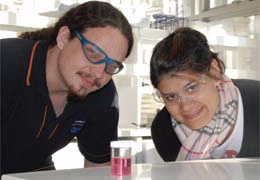 |
| Jack Goralewski and Daniela Fierro with one of their samples in the lab at ANSTO |
A new state-of-the-art facility at the Sutherland Shire’s ANSTO Lucas Heights campus is taking the guess work out of science and helping our best and brightest to better understand the world we live in.
Sutherland resident, Jack Goralewski, is a forensic scientist with ANSTO whose latest work sounds like something out of an episode of CSI.
“My current project is profiling pig bones to hopefully create a standard methodology for determining the time since death of human remains.
Pig bones are the closest replicas to human bones in their composition and chemical nature and scientists like Jack are analysing these bones to accurately establish a person’s time since death.
“We’re looking at the natural radioactivity that is in the bones to hopefully establish a post-mortem interval.”
The collaborative project with the University of Western Australia is still in its preliminary stages, but could prove to be a game changer for both archaeologists and forensic investigators alike.
Jack’s exciting work is thanks to a new one-of-a-kind measurement facility based at ANSTO that is enabling scientists to more effectively measure radioactivity in everything from sediment cores to tree ring samples.
One person who played a key role in the development of the new facility is San Souci local Daniela Fierro who is a lab technician in the centre.
As naturally occurring radiation is all around us, from the air we breath to the concrete used to construct the buildings we live and work in, it was important that the materials used in construction had the lowest levels of radiation to ensure that the building’s own radiation levels did not interrupt the measurements.
“The lead we sourced for this building is used to shield our ultra-sensitive scanning equipment against background radiation and helps us to achieve more accurate results,” Daniela said.
The new facility is set to make the Sutherland Shire a world-class centre to assist in research into area as diverse as archaeology, climate change and environmental research.


